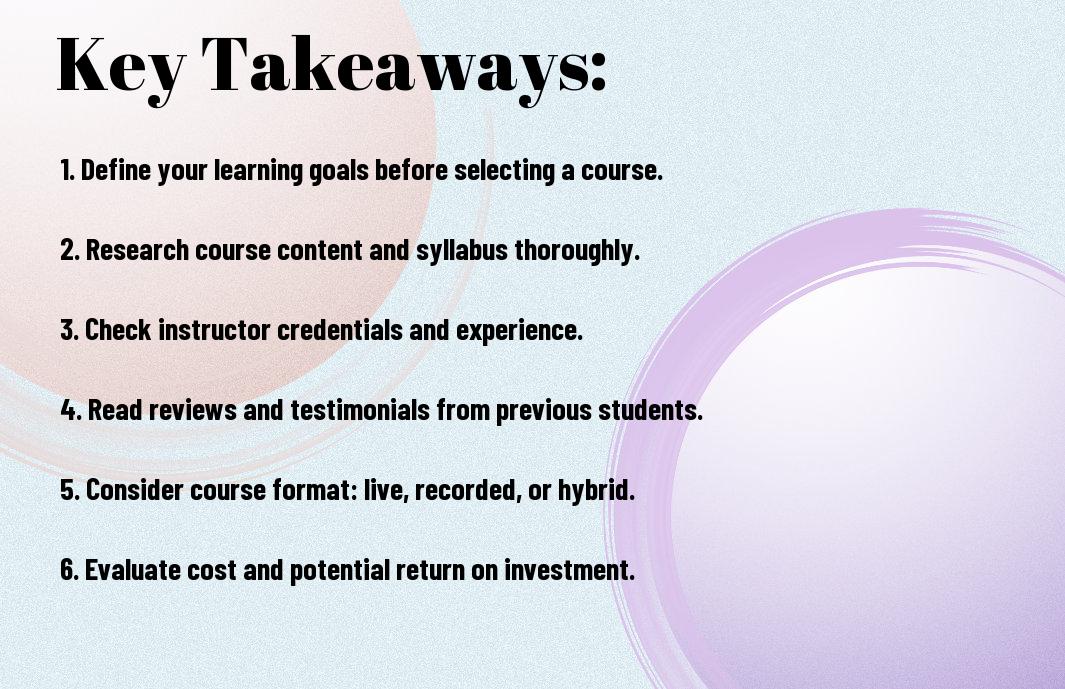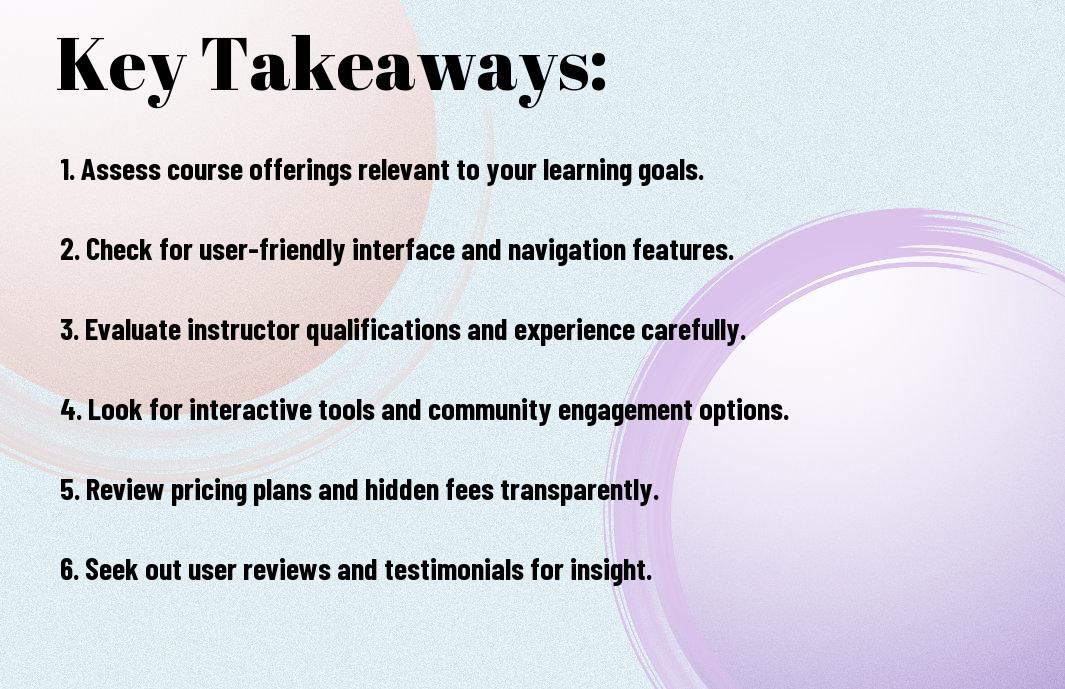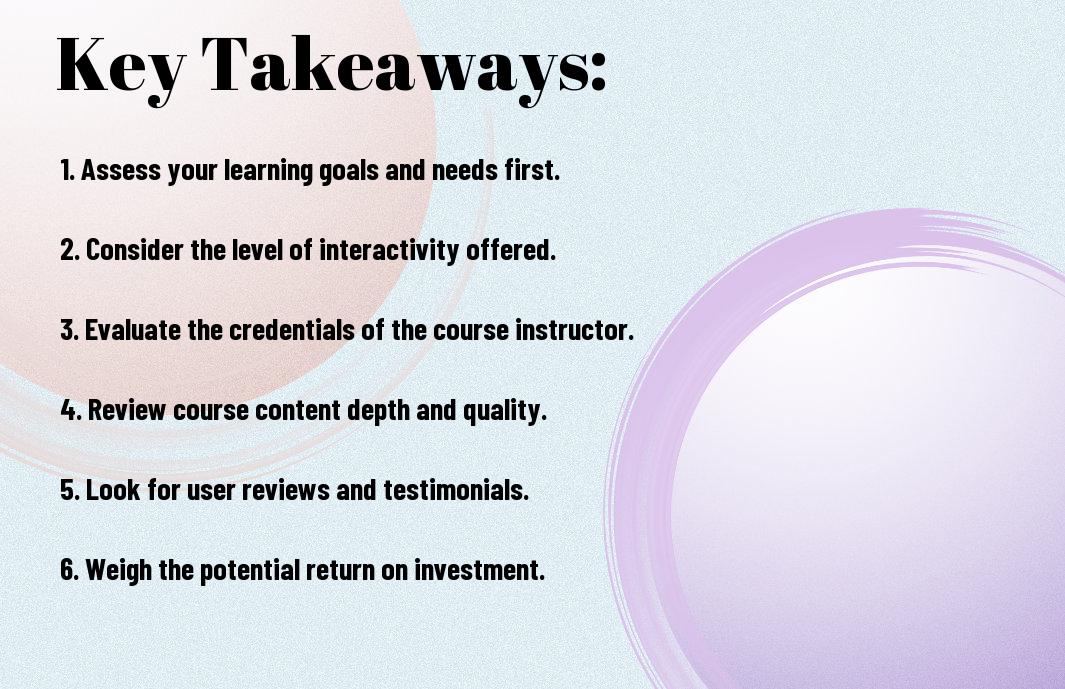As you consider furthering your education, you face a multitude of online courses, each promising to enhance your skills and knowledge. To make an informed decision, you must carefully evaluate your options. When selecting an online course, you should consider several factors to ensure it aligns with your educational and career goals. For more insights, you can explore discussions on what factors to consider when choosing an online course that suits your needs, and then make a decision that benefits your future.
Key Takeaways:
To select an online course that meets your needs, consider the following points:
- Define your Learning Goals and identify what you want to achieve from the course to ensure it aligns with your objectives.
- Assess the Course Content and ensure it covers the topics you’re interested in, with a clear outline of what you’ll learn.
- Check the Teaching Style and format of the course, such as video lessons, text-based, or interactive, to ensure it suits your Learning Preferences.
- Credibility of the course provider and instructor, including their Expertise and Reviews from past students.
- Consider the Flexibility of the course, including the Duration, Pace, and Accessibility to ensure it fits your schedule and needs.
Course Objective
Your online course should align with your interests and career aspirations, providing a clear direction for your learning journey. You need to consider what you want to achieve from the course and how it will benefit you in the long run.
Defining Your Goals
Your ultimate aim is to acquire new skills or knowledge, and selecting a course that caters to this objective is vital. You must assess what you hope to accomplish and choose a course that fits your needs.
Identifying Your Needs
Below the surface of your goals, lie specific requirements that the course must fulfill. You should consider factors such as the course format, duration, and level of difficulty to ensure it suits your learning style.
But as you explore deeper into identifying your needs, you will need to ask yourself questions about your current level of knowledge, the amount of time you can dedicate to the course, and the type of support you require from the instructor or online community. This self-reflection will enable you to make an informed decision and choose a course that meets your unique requirements.

Course Type
Assuming you have decided to take an online course, your next step is to determine the type of course that suits your needs. You will find various options available, catering to different aspects of your life, including academics and profession.
Academic Courses
By considering your academic goals, you can choose from a range of courses that align with your interests and career aspirations. You can opt for courses that offer certifications, diplomas, or degree programs, helping you achieve your educational objectives.
Professional Courses
On the other hand, professional courses can enhance your skills and knowledge in a specific area, making you more competitive in the job market. You can select courses that focus on developing your expertise, improving your productivity, and advancing your career.
Type of professional courses varies widely, from technical skills like programming and data analysis to soft skills like communication and leadership. You can choose courses that address your weaknesses, helping you become a more well-rounded professional, and increasing your chances of success in your chosen field.
Course Format
All online courses are not created equal, and you should consider the format that suits your learning style. You can find more information on Top Things to Consider When Choosing An Online Course to make an informed decision.
Video-Based Courses
Courses that use video-based instruction can be engaging and interactive, allowing you to see and hear the instructor, and often include visual aids and demonstrations to help you understand complex concepts.
Text-Based Courses
Above all, text-based courses offer a flexible and self-paced learning experience, with written materials and readings that you can access at any time, allowing you to learn at your own speed.
Consequently, as you explore text-based courses, you will find that they often include a range of materials, such as articles, ebooks, and online discussions, which can provide a comprehensive learning experience, and you can use these resources to deepen your understanding of the subject matter, and apply what you learn to your own life and work.

Course Provider
For your online learning journey, selecting the right course provider is crucial. You need to consider factors that ensure the quality of education you will receive.
Reputation and Accreditation
Beneath the surface of any course provider lies their reputation and accreditation. You should look into how they are perceived by their students and the academic community, and verify if they are accredited by relevant bodies.
Instructor Expertise
Adept instructors are vital to your learning experience. You should investigate the qualifications and experience of the instructors teaching the course, to ensure they are knowledgeable in their field.
Accreditation of instructors is also something you should look into, as it speaks to their competence and standing in their profession. You want to learn from someone who is not only an expert but also recognized as such by their peers and professional organizations. This will give you confidence in the quality of education you are receiving.
Course Reviews
Unlike other factors, course reviews offer a firsthand account of the learning experience. You can gain valuable insights from reviews, helping you make an informed decision about your online course.
Student Feedback
For instance, student feedback can provide you with details about the course content, instructor support, and overall satisfaction. You can analyze feedback to determine if the course meets your needs and expectations.
Ratings and Testimonials
About the ratings, you should look for courses with a high overall rating, as this indicates a well-structured and effective learning experience. You can also look at testimonials from previous students to get a sense of the course’s strengths and weaknesses.
Also, when evaluating ratings and testimonials, you should consider the source and credibility of the reviews. You can check if the reviews are from verified students and if they provide specific examples of their experience with the course. This will help you get a more accurate picture of what to expect from the course and make a more informed decision about your online learning journey.
Course Cost
After considering your goals and needs, you will need to think about the cost of the online course. You can learn more about Choosing the Right Online Course to make an informed decision.
Pricing Models
Across various platforms, you will find different pricing models, including subscription-based and pay-per-course options, which will affect your decision.
Value for Money
Beneath the surface of the cost, you need to consider the value you will get from the course, including the skills and knowledge you will acquire.
This value will depend on your goals and what you want to achieve with the course, so you should think carefully about what you want to get out of it and whether the cost is justified by the potential benefits, considering your budget and priorities.
Final Words
Hence, you have a clear understanding of what to consider when selecting an online course. You can now evaluate your needs and choose a course that aligns with your goals. Your decision will be informed, and you will be able to make the most of your online learning experience. By following these guidelines, you will set yourself up for success and achieve your desired outcomes.
FAQ
Q: What are the key factors to consider when selecting an online course?
A: When choosing an online course, it’s necessary to consider several factors to ensure you find the right fit. Start by defining your learning goals and what you want to achieve from the course. Consider the course content, duration, and format, as well as the level of support and interaction with instructors and peers. Additionally, look into the course provider’s reputation, reviews, and accreditation to ensure the course is credible and recognized. Finally, consider the cost and any additional resources or materials required to complete the course.
Q: How do I evaluate the quality and credibility of an online course provider?
A: Evaluating the quality and credibility of an online course provider is vital to ensure you’re investing your time and money in a reputable and effective course. Start by researching the provider’s background, mission, and values to understand their approach to online learning. Check for any relevant accreditations, certifications, or endorsements from reputable organizations. Read reviews and testimonials from past students to gain insight into their experiences and satisfaction with the course. You can also check the provider’s website for clear and transparent information about their courses, instructors, and support services.
Q: What kind of support and resources can I expect from an online course, and how do I access them?
A: The level and type of support and resources offered can vary depending on the online course provider. Typically, you can expect access to course materials, such as video lessons, readings, and assignments, as well as support from instructors through email, discussion forums, or live sessions. Some providers may also offer additional resources, such as career counseling, mentorship, or peer networking opportunities. To access these resources, usually, you’ll need to log in to the course platform, where you’ll find a dashboard with links to course materials, discussion forums, and support services. Be sure to explore the platform and familiarize yourself with the available resources to get the most out of your online learning experience.






